 The Augustinian monastery complex of Santi Quattro Coronati on the north slope of Rome’s Caelian Hill has a rich history dating to the earliest days of the Christian city. Construction of the first church was begun by Pope Miltiades in the 4th century on top of an aristocratic villa. It was one of the earliest Christian churches in Rome and its location made it one of the most important.
The Augustinian monastery complex of Santi Quattro Coronati on the north slope of Rome’s Caelian Hill has a rich history dating to the earliest days of the Christian city. Construction of the first church was begun by Pope Miltiades in the 4th century on top of an aristocratic villa. It was one of the earliest Christian churches in Rome and its location made it one of the most important.
Miltiades was pope from 311 to 314 A.D., a short but incredibly pivotal time in Church history since it saw Constantine’s defeat of Maxentius under the sign of the cross at the Battle of the Milvian Bridge in October of 312. It was Pope Miltiades who first moved into the Lateran Palace after Constantine gave it to him around 313. The basilica of Santi Quattro Coronati is a five minute walk from the Lateran Palace, so by the time construction was complete in the 6th century, the church was closely associated with the papacy.
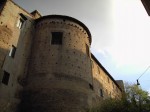 It was expanded and renovated by subsequent popes over the centuries, with more buildings added including a palace for the basilica’s titular cardinal. Much of the church was burned down in the 11th century during the Norman sack of Rome, but the original apse still stands and was incorporated into the new church built by Pope Paschal II. In the 13th century the cardinal’s residence was enlarged and reinforced by Cardinal Stefano Conti, Vicarius Urbis, so it could provide protection for the princes of the Church during the power struggle between the papacy and the Holy Roman Emperors of the Hohenstaufen dynasty.
It was expanded and renovated by subsequent popes over the centuries, with more buildings added including a palace for the basilica’s titular cardinal. Much of the church was burned down in the 11th century during the Norman sack of Rome, but the original apse still stands and was incorporated into the new church built by Pope Paschal II. In the 13th century the cardinal’s residence was enlarged and reinforced by Cardinal Stefano Conti, Vicarius Urbis, so it could provide protection for the princes of the Church during the power struggle between the papacy and the Holy Roman Emperors of the Hohenstaufen dynasty.
It was during that 13th century renovation that some artistically and historically significant frescoes were painted. On the ground floor of the fortified side of the basilica, the Chapel of Saint Sylvester was adorned with legendary scenes from the life of Pope Sylvester I and one of the earliest surviving depictions of the Donation of Constantine. On the second floor is a large hall that became known as the Gothic Hall because of the arch vaulting of the roof. It was decorated with 800 square meters of primarily profane topics like the Zodiac and Constellations, the Four Seasons, the Twelve Months, the Ages of Man, a seascape, the Liberal Arts and a panel of saints with the Virtues on their shoulders and the Vices under their feet. King Solomon, the wise judge, in the center position suggests the hall may have been used as a court of law as well as for feasting and banqueting.
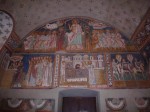
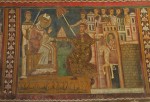
The basilica and the cardinal’s palace in particular were nearly abandoned when the papacy moved to Avignon in the 14th century. The buildings were restored by Cardinal Alfonso Carillo when the pope returned to Rome during the papacy of Martin V starting in 1417, but when the Papal Court moved from the Lateran Palace to the Apostolic Palace in the Vatican in the mid-15th century, Santi Quattro Coronati never recovered its former importance. In 1564, the complex was given to Augustinian nuns and became the monastery it still is to this day.
 Damaged by earthquakes, neglect, refurbishment that knocked holes in the walls and painted layer upon layer of plaster and solid color over the frescoes, the great Gothic Hall lost its magnificent frescoes. In 1995, a chance discovery revealed that parts of the 13th century frescoes were still there underneath the overpaint. It took a full decade of restoration by Rome’s Superintendence for Cultural Heritage to repair the damage that could be repaired. In 2007, 300 square meters of the original 800 were restored as
Damaged by earthquakes, neglect, refurbishment that knocked holes in the walls and painted layer upon layer of plaster and solid color over the frescoes, the great Gothic Hall lost its magnificent frescoes. In 1995, a chance discovery revealed that parts of the 13th century frescoes were still there underneath the overpaint. It took a full decade of restoration by Rome’s Superintendence for Cultural Heritage to repair the damage that could be repaired. In 2007, 300 square meters of the original 800 were restored as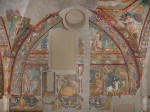 close to their former glory as possible. Very few frescoes from this period have survived in Rome, so their rediscovery and restoration is a big deal. (See this article for a wonderful description of the frescoes.)
close to their former glory as possible. Very few frescoes from this period have survived in Rome, so their rediscovery and restoration is a big deal. (See this article for a wonderful description of the frescoes.)
They couldn’t be opened to the public, however, because it’s still an active cloistered monastery. In order to make the Gothic Hall accessible, parts of the cloister needed to be restored and all the public traffic areas closed off so the presence of tourists would not violate the sisters’ religious isolation. That took another seven years and 150,000 euros donated by Arcus.
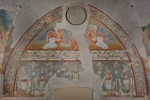 Now for the first time in its existence, the Gothic Hall can be seen by members of the general public. The hall will be open two days a month, with one group of no more than 20 visitors allowed in every hour from 8:30 – 12:30 and 2:30 – 4:30.
Now for the first time in its existence, the Gothic Hall can be seen by members of the general public. The hall will be open two days a month, with one group of no more than 20 visitors allowed in every hour from 8:30 – 12:30 and 2:30 – 4:30.